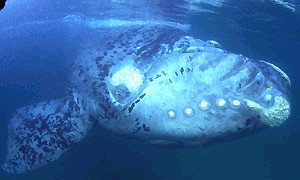|
Four deep gashes across the head of a juvenile southern right whale are graphic evidence of the dangers boats pose to the giant mammals of the ocean.
Cape Town veterinary surgeon and underwater photographer Geoff Spiby took photographs of the injuries to the whale off a reef at Smitswinkel Bay in False Bay recently.
Spiby said the gashes, each about half a metre long, could only have been caused by a boat propeller.
"And looking at the size of the wounds, it must have been a trawler."
Spiby said he was snorkelling with friends when the young whale appeared and swam with them.
The group had a magical time with the gentle giant who spent some 45 minutes up close and personal.
"She wouldn't leave us alone. She'd swim past us then turn round and come back again."
Spiby said the whale came so close to them at times that he even touched her.
"I didn't notice the wounds at first but eventually I realised something was wrong. One gash near her baleen plates seemed to have healed, but with a defect."
He said the whale didn't appear at all camera shy - even when he used a powerful strobe.
"Fortunately I had a very wide-angle lens (16mm) which was ideal for the job because without it I wouldn't have got all the detail of the whale."
Boat-based whale watching has become big business in the Western Cape but there is legislation to prevent operators from getting too close.
However every year there are reports of gung-ho operators causing havoc by venturing too close.
Nan Rice, of the Dolphin Action and Protection Group, said it was possible the whale had been hit by mistake because they often rested just below the surface.
"It was probably someone who just didn't see the whale."
But Rice said there had been a lot of complaints recently about yachts venturing too close and weaving among the whales, "although people who have permits seem to be complying with the code of conduct".
Top
|
